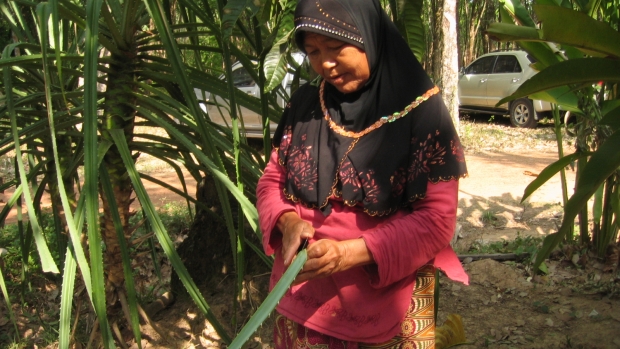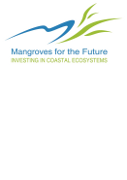Grants :: Small Grant Facilities :: Planting Pandanus palm to protect mangroves
Planting Pandanus palm to protect mangroves

Peeling Pandanus leaf for processing , Thailand © SSereepaowong , 2010
Objectives
This project had three specific objectives:
- to demarcate a “no encroachment” area of mangroves;
- to ensure sufficient Pandanus supplies to support weaving and handicrafts production aimed at increasing community incomes; and
- to increase conservation awareness and capacity among youth groups and community members.
Background
The area around Ban Khlong Yang in Koh Lanta district of Krabi province is predominantly flat land, suitable for rubber and oil palm plantations. The coastal ecosystem is a combination of wet forest and mangroves.
The Coordinating Centre of the Conservation Network for Mangrove Protection was established in 2005 by village volunteers from three villages. The Network aims to protect local marine and coastal resources. To scale up conservation activities, the volunteer group has reached out to 11 villages in the area. Through regular conservation and sustainable use activities, one of the villages was recognized by Krabi province as a model village for environmental conservation in 2008.
Target beneficiaries
People in 188 households earning a living from working on rubber and oil palm plantations, small-scale fishing, and trade and services.
Outputs
- Organisation and facilitation of a community forum for 90 stakeholders to introduce the project’s objectives and approaches, and to gain support and agreement from local landowners and government officials.
- Establishment of a no-encroachment boundary line extending about three kilometres across local mangroves and marked on large-scale maps.
- Planting of 2,700 Pandanus plants (with an 80% survival rate) along the boundary line to protect about one hectare of mangroves.
Accomplishments and challenges
Community leaders, government officers and landowners came to a mutual understanding regarding the use of marginal land to be planted with Pandanus.
Demarcating the mangrove area indirectly helped to reduce water pollution and improve the condition of the mangroves.
Community members now have an adequate supply of Pandanus for use in weaving and handicrafts, and as a result have started to gain some supplementary income.
Lastly, local youth group members have a better understanding of the value of conserving mangroves and coastal resources.
Challenges
Unclear boundaries between private land and public mangrove areas were a challenge. Because of disputed boundaries, several landowners did not allow any Pandanus planting. The project organized negotiations with these landowners in open fora that included women and youth groups. These were successful in several cases, allowing the project to plant Pandanus on private land.
Contributions to cross-cutting themes
Gender equality
The local Pandanus Weaver Women’s Group took the lead in the project’s handicraft support activity.
Lessons Learned
The Pandanus Weaver Women’s Group managed to generate some income from the products they sold, as well as pass on their knowledge to youth groups in the community school. Members of the group demonstrated their skills in weaving with enthusiasm, even though it is a time-consuming activity. Producing a mat of two square metres takes about 10 days, for example. However, the returns are thought to be worth the effort, particularly as prices are strong. The current price of dyed Pandanus fibre is about US$13–17 per kg.
Project beneficiaries will continue to monitor and prevent any encroachment in the reforested Pandanus areas, promote supplementary income generation, especially through weavers’ groups, and teach local knowledge about Pandanus weaving in community schools to instil conservation awareness in younger generations.
Project Facts
Country
Location
Ban Khlong Yang, Koh Lanta, Krabi, Thailand
Topic
Duration
1st May 2009 to 30th Nov 2010
MFF Grant Amount
US$9,696
Co-financing Partner
The participating communities made an in-kind contribution valued at US$10,750, and the Khlong Yang Sub-district Administrative Organization contributed US$734 in cash.
Implementing Partner
Mr Phisit Thongkhong
Project Manager
Coordinating Centre of the Conservation
Network for Mangrove Protection
c/o Ban Khoke Yung School, Moo 3,
Khlong Yang, Koh Lanta,
Krabi 81120, Thailand
Tel: +66 89 5116851
Email: t_pisit28@hotmail.com
“The community set up a good example for conservation. It is difficult to see how this project could be replicated or scaled up successfully within a few years, unless there is practical policy support and systematic enforcement.”
— MR PHISIT THONGKHONG
PROJECT MANAGER
Related Publications

Planting Pandanus for protection of Mangrove
Author: MFF Thailand
Posted on: 4th Dec 2013
Category:
Size: 2.8 MB
